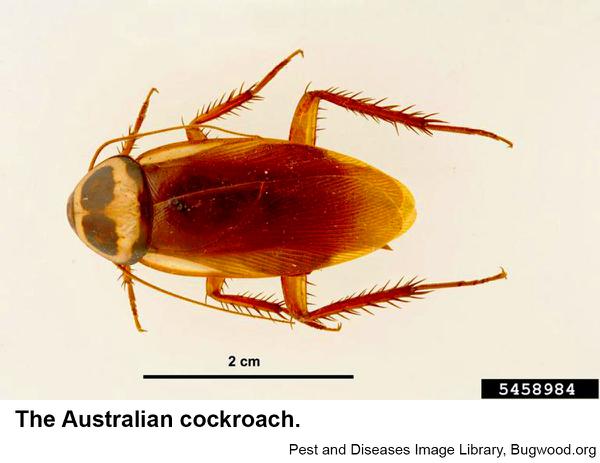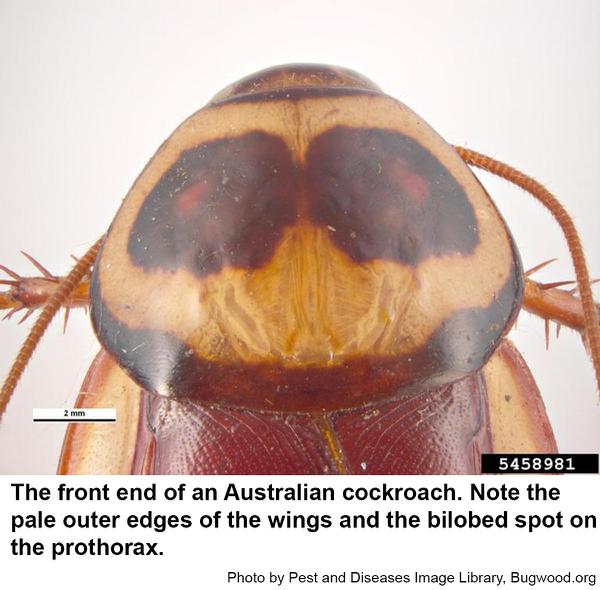Description and Biology
The Australian cockroach, also known as a waterbug or the “shad roach,” Periplaneta australasiae, is an inch long, dark brown cockroach with pale yellow to orange bands on the outer margins of the forewings and an irregular pale band around the prothorax that defines a two-lobed dark spot. Eggs are laid in a brown, oval ootheca or egg capsule about 3/8 inch long that is carried by the female for a few days and then glued to some substrate usually in a crack or crevice. Females produce 20 to 30 egg capsules in their live spans of 4 to 6 months. Usually 12 to 24 nymphs hatch between 40 days and 3 months. It takes about a year for this species to develop into the adult stage. Young nymphs are small and very dark brown. They have a pale band across the thorax and two pale spots on the abdomen. Older nymphs are variously spotted and develop wing buds as they molt and grow. The Australian cockroach prefers warm, damp places outdoors or in greenhouses, interiorscapes, and other buildings that have warm, damp situations. When a pest in buildings, it usually infests only the bottom floor.
Host Plants
Australian cockroaches sometimes feed on tender seedlings and tender foliage of ornamental plants, although they also feed on starchy substances including unprotected food.
Residential Recommendations
Fortunately, the Australian cockroach is not particularly resistant to pesticides. However, some pesticides cannot be used in interiorscapes and hobby greenhouses. Consider using abamectin cockroach baits. These baits are highly effective for other pest species of cockroaches, and there is no reason to believe they will not give more than adequate control of the Australian cockroach.
References
- Cockroach Species File Online. Beccaloni, G. et al. 2021. Cockroach Species File.org
- Common name: Australian cockroach, scientific name: Periplaneta australasiae Fabricius (Insecta: Blattodea: Blattidae). Jiang, S. and P. E. Kaufman. 2015. Featured Creatures. Entomology & Nematology, FDACS/DPI, EDIS. Publication Number: EENY-623.
- Extension Plant Pathology Publications and Factsheets
- Horticultural Science Publications
- North Carolina Agricultural Chemicals Manual
For assistance with a specific problem, contact your local Cooperative Extension Center
This Factsheet has not been peer reviewed.
Publication date: March 15, 2017
Reviewed/Revised: Dec. 22, 2021
Recommendations for the use of agricultural chemicals are included in this publication as a convenience to the reader. The use of brand names and any mention or listing of commercial products or services in this publication does not imply endorsement by NC State University or N.C. A&T State University nor discrimination against similar products or services not mentioned. Individuals who use agricultural chemicals are responsible for ensuring that the intended use complies with current regulations and conforms to the product label. Be sure to obtain current information about usage regulations and examine a current product label before applying any chemical. For assistance, contact your local N.C. Cooperative Extension county center.
N.C. Cooperative Extension prohibits discrimination and harassment regardless of age, color, disability, family and marital status, gender identity, national origin, political beliefs, race, religion, sex (including pregnancy), sexual orientation and veteran status.



